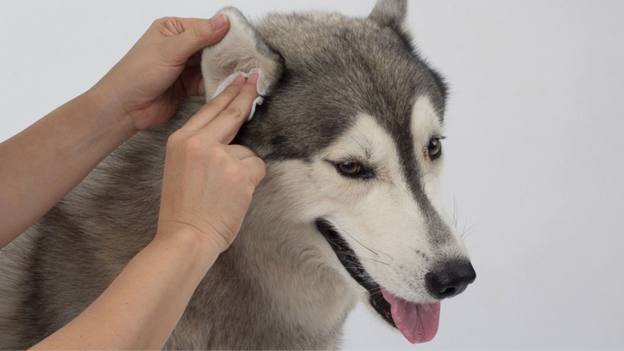
Understanding and Managing Dog Ear Infections
Whinny’s Wisdoms

Greetings, dear readers! Whinny here, your trusty guide through the curious world of dog ear infections. Today, we’re going to delve into the fascinating realm of these “ear-resistible” troubles that our furry friends, like Fido and Fluffy, sometimes encounter. So, grab your metaphorical magnifying glasses, and let’s explore the intricacies of ear infections in our four-legged pals.
The Anatomy of a Dog’s Ear
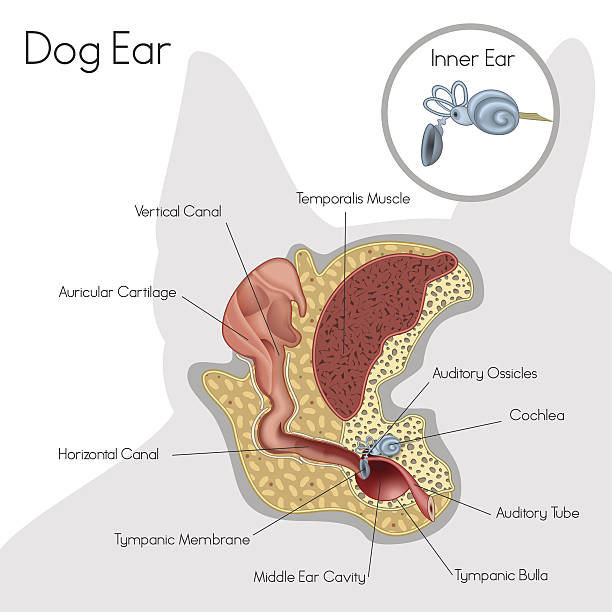
First off, let me introduce you to the ear-tastic design of our canine companions’ auditory apparatus. Unlike your straightforward (aka boring) human ears, a dog’s ear canal takes on a peculiar “J” shape, with both vertical and horizontal segments. It’s like a doggy labyrinth in there! This unique architecture presents a challenge for debris, as it must defy gravity to exit. Instead of a straightforward exit strategy, it’s an uphill battle.
Accumulation and Infection
Now, here’s where the plot thickens. Accumulation in the ear canal is like an all-you-can-eat buffet for bacteria and fungi. Earwax, skin oil, dirt, and other debris, when left to their own devices, create a petri dish for microorganisms to thrive. These tiny troublemakers typically coexist with a dog’s ear but under control. However, when excess moisture and debris are on the menu, they go from being polite dinner guests to party crashers, leading to a full-blown ear infection. Most often ear infections are multi-species, with both fungus and bacteria causing issues.
So, what contributes to this ear-wax-gone-wild scenario, you ask? Well, here are the culprits:
- Congenital or Breed Predisposition: Some dogs are more predisposed to ear infections due to their breed’s ear shape or good old genetics. It’s like having a mouse-sized doorway in a mouse hole; it just doesn’t work.
- Water Woes: Leaving water in the ear after a bath or a swim creates the ideal environment for microbial growth. It’s a bit like us mice diving headfirst into a river – not our favorite activity.
- Underlying Health Conditions: Certain diseases can lead to abnormal earwax buildup, as if we mice had a never-ending stash of cheese. It’s not a good thing.
- Skin Allergies: Dogs with skin allergies, akin to us mice with a sudden cheese allergy, are especially prone to ear infections. The earwax moisture is a welcome mat for bacteria and yeast.
Managing and Treating Ear Infections
Fear not, dear pet owners! Ear infections are typically manageable and can be cleared up with the right treatment. However, like a wedge of cheese, you mustn’t cut it too soon; follow your veterinarian’s guidance for treatment once a diagnosis is made. Stopping treatment prematurely can leave the infection lingering like a cheesy aftertaste. Most often, we will take a sample swab of both ears and examine them under the microscope after a special staining procedure to identify the type of infection. We can then use this same test to check our work after a course of treatment.
If the infection keeps showing up like a mouse at a cheese convention, further testing may be required. Allergies are often the sneakiest suspects behind recurring ear problems. They can be environmental or food-related and often sneak in like a mouse in the night. Hormone imbalances can also be accomplices in this ear mystery.
Preventing Ear Infections
Prevention is the key to a harmonious life with your furry friend. Here are some tips to keep ear infections at bay:
- Regular Cleaning: Gently clean your pet’s ears with a veterinarian-approved ear cleaner to whisk away excess wax and debris. No need to dig for buried treasure; a gentle touch will do.

Whinny Wisdom: To achieve clean ears without fear, here’s the best plan: soak two cotton balls with the ear cleaner, then put the bottle away. Gently push one cotton ball into each ear canal–don’t worry, they won’t get stuck—and cover the canal with your dog’s ear flaps. Gently massage at the base until you hear a nice squishy sound. If tolerated, massage for about 30 seconds, then stand back! Your dog will shake out both cotton balls on their own, bringing lots of debris with it. Then, you can use clean cotton balls or gauze to wipe away the shaken loose debris.
- Drying Ears: After baths or swims, ensure your pet’s ears are bone dry. No puddles or soggy surprises allowed!
- Allergy Management: If your pet has allergies, work closely with your veterinarian to navigate them like a mouse through a maze. Allergies often lead to skin problems, including ear infections. I’ve got another blog covering all things allergy: Allergy Blog
- Regular Check-Ups: Schedule regular check-ups with your veterinarian to catch potential ear capers early and nip them in the bud.
Conclusion
In conclusion, ear infections are like that rogue mouse in the pantry—unwanted, but manageable. Understanding the unique ear anatomy and potential causes of ear infections in dogs is the first step in keeping Fido’s, Fluffy’s, and everyone else’s ears in top-notch shape. By taking steps to manage allergies, maintain clean ears, and seek prompt veterinary care when needed, you’ll provide your pets with the best possible ear health and overall well-being.
So, there you have it, folks, a mouse’s perspective on dog ear infections. For the record, cat ear infections work about the same way and most of this will apply to our feline friends as wellKeep your ears perked and tails wagging, and remember that knowledge is your best weapon against these ear-enemies.
Until next time, cheese enthusiasts!
~Whinny
P.S. If you’re looking for some stocking stuffer ideas for a horse-crazy teen in your life, we have the perfect book! The world needs more equine vets, and we need your help to get them prepared for the difficult task of getting into vet school. This book is for young people age 12 to adult. Click Here to learn more!

 Whinny’s Wisdoms is the official blog of Whinny the Clinic Mouse at Springhill Equine Veterinary Clinic in Newberry, Florida. If you liked this blog, please subscribe below, and share it with your friends on social media! For more information, please call us at (352) 472-1620, visit our website at SpringhillEquine.com, or follow us on Facebook!
Whinny’s Wisdoms is the official blog of Whinny the Clinic Mouse at Springhill Equine Veterinary Clinic in Newberry, Florida. If you liked this blog, please subscribe below, and share it with your friends on social media! For more information, please call us at (352) 472-1620, visit our website at SpringhillEquine.com, or follow us on Facebook!
[jetpack_subscription_form title="Subscribe to Whinny's Wisdoms"]

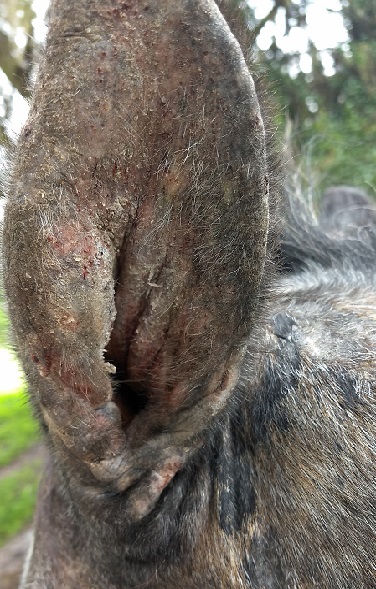
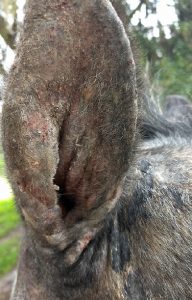 Culicoides (kyōō′lĭ-koi′dēz′) is a species of gnat very common here in Florida. Many horses are actually allergic to the saliva of this gnat, so every bite by one of these annoying little devils sends the poor horse into an itching frenzy. The early signs of this gnat allergy include frequent scratching and hair loss in the ears, mane, base of tail, and chest. Over time the skin in these places will become thickened, there will be multiple open bite wounds, the hair will be completely gone, and the horse will constantly be scratching on anything and everything he can find. Horses with chronic Culicoides hypersensitivity will often develop a “cauliflower ear” appearance over a period of years. Once this happens, the ears will never return to their original shape.
Culicoides (kyōō′lĭ-koi′dēz′) is a species of gnat very common here in Florida. Many horses are actually allergic to the saliva of this gnat, so every bite by one of these annoying little devils sends the poor horse into an itching frenzy. The early signs of this gnat allergy include frequent scratching and hair loss in the ears, mane, base of tail, and chest. Over time the skin in these places will become thickened, there will be multiple open bite wounds, the hair will be completely gone, and the horse will constantly be scratching on anything and everything he can find. Horses with chronic Culicoides hypersensitivity will often develop a “cauliflower ear” appearance over a period of years. Once this happens, the ears will never return to their original shape.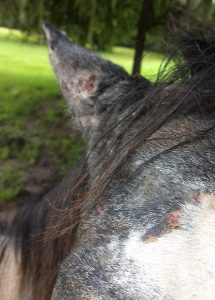 Once the ear has gotten to a point where there is a secondary laceration, abscess, or hematoma, it can be difficult to treat. While we always try conservative options first, these horses sometimes have to undergo surgery under general anesthesia to drain the ear, followed by weeks with the ear taped down against the horse’s head to allow for continued drainage. No fun.
Once the ear has gotten to a point where there is a secondary laceration, abscess, or hematoma, it can be difficult to treat. While we always try conservative options first, these horses sometimes have to undergo surgery under general anesthesia to drain the ear, followed by weeks with the ear taped down against the horse’s head to allow for continued drainage. No fun.